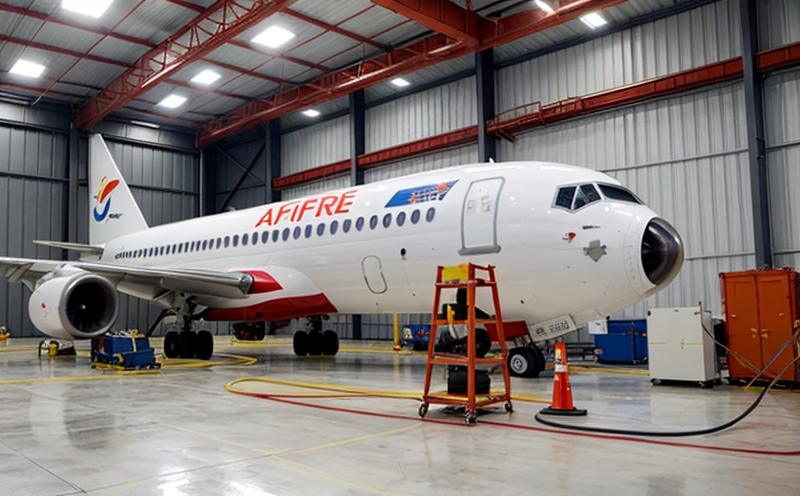Fire Performance Testing of Aircraft Seat Frames
The fire performance testing of aircraft seat frames is a critical aspect of ensuring passenger safety and compliance with stringent aviation regulations. This testing evaluates the ability of seat frames to withstand exposure to intense heat and flame, thereby preventing the spread of fire in case of an onboard emergency.
Aircraft seating must meet specific standards set forth by organizations such as the Federal Aviation Administration (FAA) and European Union Aviation Safety Agency (EASA). These regulations are designed to minimize potential risks associated with fire incidents. By conducting thorough testing, manufacturers can ensure their products comply with these requirements, safeguarding both passengers and crew.
The process involves subjecting seat frames to controlled environments that simulate real-world conditions during a fire event. This includes exposure to high temperatures, flames, and smoke. The goal is to assess how well the frame material resists damage under such stressors while also investigating any potential for ignition or propagation of flames from adjacent materials.
Testing procedures typically involve placing samples within an enclosed chamber where they are exposed to specified levels of heat and flame intensity. Specimens may include full-size seat frames or smaller components depending on the scope of evaluation required by regulators. Once testing concludes, results are analyzed based on prescribed criteria outlined in relevant standards documents.
Proper preparation of specimens prior to testing is crucial for accurate assessments. This involves cleaning surfaces thoroughly and ensuring consistent orientation throughout each trial run. Compliance officers play a vital role here as they ensure all preparatory steps adhere strictly to specified protocols.
Aerospace fire safety testing focuses not only on individual materials but also examines assemblies like seat frames as complete units because real-world scenarios often involve multiple interacting components. Understanding how these parts behave together during an emergency situation helps identify weak points that could compromise overall structural integrity.
Real-world examples underscore the importance of rigorous testing practices. For instance, a notable incident involving a commercial airliner highlighted the necessity for enhanced fire protection measures in seating design. Following this event, manufacturers intensified efforts to develop safer alternatives using advanced materials and improved manufacturing techniques.
In conclusion, comprehensive fire performance testing ensures that aircraft seat frames are reliable and safe under extreme conditions. It contributes significantly towards maintaining high standards of aviation safety worldwide by validating compliance with established guidelines.
Industry Applications
| Application | Description |
|---|---|
| Airbus A350 XWB | Ensuring seat frames meet FAA and EASA standards for fire resistance. |
| Bombardier CSeries | Evaluating the ability of seat frames to resist fire without compromising structural integrity. |
| Boeing 787 Dreamliner | Testing compliance with international regulations regarding flammability and heat resistance. |
| Application | Description |
|---|---|
| Airbus A320 Family | Verifying that seat frames comply with specific fire performance requirements specified by the FAA. |
| Bombardier C Series | Evaluating the effectiveness of different materials used in constructing seat frames against fire hazards. |
| Boeing 737 MAX | Assessing the impact of various design changes on the overall fire resistance capabilities of seat frames. |
Why Choose This Test
The decision to invest in fire performance testing for aircraft seat frames is driven by several factors. Firstly, it ensures compliance with regulatory requirements set forth by aviation authorities such as the FAA and EASA. These standards are designed to protect passengers and crew from potential hazards associated with fires onboard aircraft.
Secondly, conducting this type of testing helps manufacturers identify areas where improvements can be made in terms of material selection or design modifications that enhance fire resistance properties. For example, certain composite materials have shown promising results when it comes to reducing flammability while maintaining structural strength.
Thirdly, there is an increasing trend towards incorporating sustainable practices into aircraft manufacturing processes. Fire performance testing plays a key role in this regard by encouraging the use of eco-friendly alternatives that not only pass stringent safety tests but also contribute positively to environmental sustainability goals.
In addition to these benefits, performing regular fire performance tests allows airlines and manufacturers alike to maintain their reputation for reliability and quality assurance. In today's competitive market, maintaining a strong brand image is crucial for long-term success.
Finally, given the high stakes involved in aviation safety, choosing this test demonstrates a commitment to excellence that extends beyond mere compliance with regulations. It reflects an ongoing dedication to innovation and improvement within the industry.
International Acceptance and Recognition
The fire performance testing of aircraft seat frames is widely recognized and accepted across various international bodies responsible for aviation safety standards. Organizations such as the FAA, EASA, and International Civil Aviation Organization (ICAO) all emphasize the importance of these tests in ensuring passenger safety.
For instance, the FAA requires manufacturers to demonstrate that their products comply with certain fire resistance criteria before being approved for use on commercial aircraft. Similarly, EASA has established specific guidelines aimed at preventing fires from spreading rapidly through seating areas. Compliance with these regulations is essential not only for obtaining certification but also for maintaining it over time.
ICAO plays a crucial role in setting global standards that member states must adhere to when regulating aviation safety within their territories. By aligning national practices with international norms, countries can ensure consistency and interoperability among different systems worldwide.
Moreover, many aircraft manufacturers voluntarily exceed the minimum requirements stipulated by regulatory bodies out of concern for public welfare. They recognize the value of conducting additional tests beyond what is strictly mandated because it allows them to introduce cutting-edge technologies into their designs sooner than competitors might otherwise do so.
The widespread acceptance and recognition of fire performance testing contribute significantly to fostering trust between stakeholders involved in aviation operations, from original equipment manufacturers (OEMs) to operators and passengers alike. This trust translates into greater confidence in the reliability and safety of aircraft seating systems.





